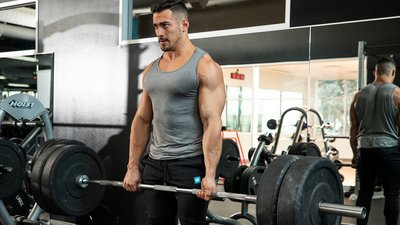When it comes to building functional strength, power, and resiliency, nothing beats the deadlift. But as powerful of a tool as this lift is, it also happens to be the exercise that is most notoriously associated with pain and injuries, including the lower back and, in many cases, even the shoulders.
While there's nothing inherently dangerous about the barbell deadlift when it's executed properly, loaded intelligently, and scaled specifically for the person training, lifters' tendency to "force-feed" the traditional barbell deadlift in their programming has absolutely played a role in earning its injurious reputation.
That's why in my Bodybuilding.com BodyFit Elite course, Unstoppable: The Ultimate Guide to Training Through Injury, I advise treating the deadlift like a spectrum of movements, not a single movement. Everything from the cable pull-through to the trap bar deadlift should be considered a deadlift and can have a place in any lifter's training. But I get it: There's a time and a place for a barbell, too!
So before you shy away from barbell deads because they're going to "hurt your back," or make the mistake of "just going light" to avoid cranky shoulders, try these three techniques to get the most out of the king of pulls. Train the deadlift smarter, achieve superior strength results, and do it all without destroying your body in the process!
Technique 1: Ride the Double Overhand Grip for All It's Worth
The hands are underappreciated in their ability to bulletproof the shoulders and spine against pain and injuries. Seriously: Increased grip strength has been consistently associated in research with higher degrees of shoulder and core stability, two things that are necessary for pulling big weights with safe and stable spinal positions.
It all works by the neurological power of what is known as "irradiation." Simply put, the stronger and more aggressively you're able to grip the bar, the stronger and more stable the shoulders (the most inherently mobile joints in the human body) will be from increased activation and tension recruitment.
Where many lifters go wrong is by nearly always deadlifting with a mixed grip or with straps and never truly building their grip strength to actually own the weights that they pull. A quick and easy solution to this is prioritizing the traditional double overhand grip and using it until your grip truly becomes a limiting factor to completing the lifts. This will give your grip the increased work it is in dire need of, while also allowing a more symmetrical setup for your upper body and shoulders during the pull.
Want some even more blunt truth? Here you go: Unless you are a competitive powerlifter or barbell sport athlete, there is truly no reason to use a mixed grip. It's harder on your shoulders and, more specifically, your biceps tendons. A superior pain-free grip alternative is to pull the double overhand grip as long as you can, and then strap up only for the sets where grip becomes a clear limiting factor.
No, you're not "weak" for using straps on those top sets—you're just a smarter lifter who values their health more than their short-term ego.
Technique 2: Embrace the Power of the Rack Pull
Contrary to the prevailing dogma, some people are simply not built to deadlift the barbell off the floor. Probably more people aren't than are, in fact!
But force-feeding the barbell deadlift to a person who is simply incapable of getting into a sound spinally-neutral position to work from is a common mistake that is made across all demographics in the fitness industry. From CrossFit to the commercial gyms, adding heavy loads and high volumes to spinally-flexed positions usually results in anything but superior muscle and strength results.
Fortunately, custom fitting an optimal pulling height for the deadlift doesn't have to be rocket science. Utilizing smarter setups like pulling off the safety bars in a power rack, or off boxes or plates on the ground, will help almost anyone find a more sound spinal position in their starting position. Seriously: Decreasing the range of motion at setup is the easiest fix lifters, from beginners to veterans, can make to maximize training while reducing joint stress.
Not having to significantly flex the lower back to initiate the deadlift off the ground is a plus for long-term health, but it also has some pretty intriguing strength benefits. Since the higher starting bar height produces a partial-range-of-motion rep, this variation of the deadlift is able to be loaded more aggressively, with less risk of poor form or ugly reps.
Want a tried-and-true approach? Get as strong as possible in the ranges of motion that you own with proper form, and from there, work on expanding your range over time. That's how you get strong and do it pain free.
Technique 3: Milk the Last Deadlift Rep of the Day
Why do most people skip out on deadlifts—other than the obvious that they've jacked up their backs or shoulders previously training them? It's because each and every rep of heavy deadlifts is seriously hard, full-body work. When performed well, the deadlift trains the glutes, hamstrings, lower back, core, lats, traps, forearms, grip, calves, feet, and a bunch of little intrinsic areas that you probably didn't even know existed before they got sore after heavy pulls.
So, if you're already putting in the damn work, why not get the very most out of the deadlift from a muscle, strength, and core stability standpoint? Here's what to do: On your last deadlift set of the day, knock out some pretty reps with a challenging weight. Then, at the top of your last deadlift rep, hold it in the top position for as long as humanly possible.
But don't make the mistake of just chilling out and waiting for your grip to fail! This should be maximal full-body tension, gripping as hard as possible with your hands, squeezing your adductors and glutes hard to stabilize the hips, flexing your lats and pecs hard to keep the shoulders in place, and keeping that core braced like you are about to get kicked in the gut.
As soon as one of those key regions of the pillar—shoulders, hips, core—fail or lose position, the hold is over. Test your limits, not only physical, but mental, and end each deadlift session with a bang.

